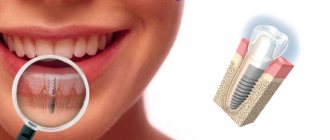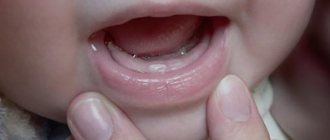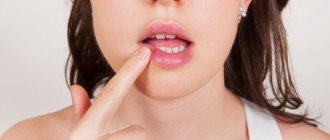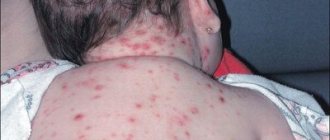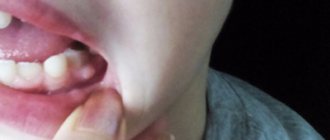Causes of the rash
Due to the fact that the baby is going through a period of adaptation to the environment in his life, rashes on the body are not something supernatural. This is how a very small organism perceives life changes.
Often this phenomenon is due to completely different reasons that have nothing to do with the growth of baby teeth.
The following reasons are probable:
- The body's sensitivity to innovations in nutrition.
- Allergy to household chemicals.
- Excessive salivation as baby teeth grow.
- Genetic predisposition to allergies.
- The influence of external stimuli on a young, fragile organism.
Teething
Skin rashes may appear as a result of exposure to one of the listed factors.
It is very difficult to understand the true cause of irritation and say unambiguously whether it is related to tooth growth or not. Taking into account the true cause of the rash, appropriate therapy is prescribed.
Causes of allergic rashes with cutting baby teeth
The process of teething in a baby is usually accompanied by a lot of discomfort:
- Pain in the gum area.
- Itching and burning.
- Sleep disturbance.
- Refusal to eat.
- Increased moodiness.
During this period, the baby experiences real stress , and rashes appear, as a rule, precisely because of this irritating factor. Pediatricians around the world have a special term that characterizes the condition - “cytokine surge.”
The reasons for the appearance of a rash on the skin of a child during teething are considered to be a weakening of the general protective function of the body, immunity decreases, which becomes the cause of the development of all kinds of infectious diseases. There is also a decrease in resistance to chemicals found in food and hygiene products.
Rash and teething: how they are connected
It's no secret that during the period of growth of baby teeth, babies become very irritable, as the process is accompanied by severe pain and discomfort. The baby sleeps little, his gums itch, and he cries constantly. Due to severe stress, salivation increases.
The occurrence of a rash is caused by the body's reaction to such a shock. A teething rash, as in the photo below, has a special medical name - “cytokine explosion.”
The appearance of rashes in a baby may be due to a reaction to some unknown product, household chemicals, or clothing. An infection may be to blame. In order to correctly determine the appearance of irritation on the skin, it is necessary to undergo a special medical examination and pass all the necessary tests.
Taking into account the results of the examination, therapeutic tactics are determined.
Types of teething disorders
Teething in children, the sequence of which is clearly defined, can occur with a delay caused by various reasons (illness of the mother during pregnancy, diseases suffered by the child, etc.). Due to the delay, deformation of the jaws may begin, because There is not enough free space for teeth that have not yet erupted. In this case, only the dentist can decide on treatment after a thorough visual examination of the child and analysis of the photograph taken.
The next very common disorder is enamel hypoplasia, which manifests itself in spots of different colors on newly emerging teeth, pits or grooves. Hypoplasia causes complications during pregnancy.
Localization of rashes
There are likely to be different stages and phasing of the appearance of rashes in a baby as a result of teething. Most often, skin irritation makes itself felt in the neck area. The process then spreads to the limbs, abdomen and other parts of the baby’s body.
The rash on the teeth may be dry, somewhat rough, and accompanied by a strong burning sensation. Often the nature of the occurrence of such a phenomenon affects not only close people around the baby, but also experienced doctors.
It is worth emphasizing once again that this is a peculiar reaction of the body to many provocateurs, each of which requires special attention.
Symptoms
Depending on the different stages and stages of teething, the rashes can be localized on different parts of the body. As a rule, irritation is localized in the area of the neck folds . It is also possible for the rash to spread to the upper and lower extremities, abdomen and back.
The nature of the rash may be:
- Dry.
- Rough.
- Accompanied by severe itching.
Rashes on the body
Most often, a rash on a child’s teeth appears in the most visible areas - the neck and face.
A similar phenomenon occurs in many places. It may be difficult to see and roughness may form on the baby’s skin. This phenomenon can be due to many reasons:
- baby's reaction to stressful stimuli . This period in a child’s life is very difficult and simply cannot be completely painless. At the same time, the load on the psyche increases significantly;
- Another serious cause of this phenomenon may be a lack of calcium. This is due to the simultaneous eruption of several teeth, which implies the need for an increased dose of calcium. The lack of this component is reflected in skin rashes.
Skin reactions should never be ignored. At the time of occurrence, you should not buy new clothes for your baby; all things, household chemicals and household items should be hypoallergenic. You should also not forget about nutrition; be sure to adjust your child’s diet.
Atopic dermatitis in children
Children's bodies are susceptible to many diseases, and one of the most common is atopic dermatitis. This inflammatory disease is allergic in nature and chronic in nature. Atopic dermatitis in children is expressed in peeling of the skin and itching, and is treated by an allergist.
What is atopic dermatitis?
This is a pathology of the epidermis, which is characterized by chronic immune inflammation. According to statistics, approximately every fifth child in the world experiences symptoms of atopic dermatitis. Most often, foci of inflammation develop in the area of the cheeks and folds, as well as in the area under the diaper.
The disease is characterized by a pronounced allergic nature and is associated with manifestations of immune dysfunction, which include food allergies, rhinitis, conjunctivitis, etc.
Lack of proper treatment can result in the development of severe forms of the disease. Also, neglect of qualified help threatens atopic march - a condition in which the disease “marches” throughout the baby’s body. This aggravates existing diseases and provokes the emergence of new ones. Contrary to misconceptions, atopic dermatitis in children does not go away with age.
Symptoms of atopic dermatitis in children
Symptoms of the disease depend on age. In this case, three phases are distinguished: infant, child and adult. The following symptoms are characteristic of each phase:
- symmetrical inflammation and redness
- dry skin that cannot be eliminated with cream
- severe itching causing discomfort
The disease has a direct connection with dysfunction of the epidermis. It is characterized by alternating periods of exacerbation with remissions. And, as a rule, in winter the situation worsens, and with the onset of the warm season, improvement is observed.
Stages of atopic dermatitis in children
There are two stages of the disease in accordance with the nature of the course, namely:
- acute - the skin becomes covered with rough red spots and papules, and crusts also appear, swelling is observed
- chronic - pigmentation on the skin of the eyelids increases, cracks form on the palms and soles, which is accompanied by thickening of the skin.
Causes of the disease
Dermatitis has a hereditary predisposition, and the main factor in its occurrence is genetic. If the parents have suffered from the disease, the probability of it developing in the child is about 80%.
In addition, the following causes that affect the mother’s body and fetal development can trigger the appearance of atopic dermatitis:
- unbalanced diet
- exposure to toxic substances
- infectious diseases
- regular stress
Children who have suffered oxygen deprivation or were born prematurely are also especially susceptible to atopic dermatitis.
Diagnosis and treatment of atopic dermatitis
Diagnosis can only be made by a dermatologist. As part of the examination, the specialist prescribes blood tests (general and biochemistry), urine analysis, skin biopsy, etc. In accordance with the research results, an individual treatment plan is prescribed.
Signs on the face
Most often, a rash on a child’s teeth makes itself felt in the most visible areas – the neck and face. Folk remedies usually do not help with such phenomena, since self-diagnosis by parents, grandmothers and other family members cannot be correct. This requires a professional approach.
It is worth noting that the use of various ointments in infants for other purposes does not usually end well , but only entails a number of unpleasant consequences. It makes sense to undergo a full examination in order to establish the correct diagnosis.
A characteristic phenomenon often occurs due to banal non-compliance with hygienic principles by the baby’s parents. This is especially evident when using low-quality household chemicals . That is why cosmetics, detergents and laundry detergents for babies should be selected very carefully.
During the period of growth of baby teeth, a baby's immunity weakens due to severe stress, which results in rashes on the face.
Treatment of imbalance in newborns
There is no need to rush into introducing different bacteria into your baby’s diet. An experienced doctor will most likely initially recommend that a young mother arrange meals for her baby according to a specific schedule. The main thing is not to overfeed the baby and allow the microflora of the stomach to form on its own. Treatment will only be required if test results require it.
You can introduce medications into the treatment process for dysbiosis only if your doctor prescribes them for you. It is worth remembering that treatment should be solely for the benefit of the baby. Imbalance at this age can be treated over a fairly long period of time.
At the moment, there are a number of drugs that are enriched with bacteria required for treatment:
Burning and rash on the neck
When a rash appears, it is recommended to give the child herbal baths.
It is worth noting that the rashes do not appear on their own. Usually, symptoms during teething occur all in a heap: irritability, intense salivation, fever. In this situation, herbal baths are very effective.
It is useful to take baths with celandine, chamomile and other anti-inflammatory plants . After the bathing procedure, it is advisable to lubricate the baby’s body with healing ointments. In this situation, good old baby cream often saves the day. You can use special creams containing panthenol.
Aerial procedures have a special effect. With severe burning, even the use of soft clothing has a strong irritating effect. Air baths provide effective treatment for skin rashes.
How to speed up the process
Often, adults look forward to teething, but there are still no symptoms. What to do in this situation? Until the tooth grows completely, the process is accompanied by many difficulties. The very first obstacle is the bone and crown. After this, the tooth also overcomes the mucous part, which is quite difficult, because this tissue is quite elastic.
To stimulate the teething process, the baby’s saliva contains special components that straighten the mucous membrane and promote the rupture and birth of the tooth. In addition, baby saliva is an antibacterial liquid that helps fight infection, which often occurs as a result of tooth growth.
Adults should take note of the fact that it is impossible to speed up the natural process of tooth growth. This is not at all practical or relevant. No drugs will help.
All products containing calcium will be excreted from the body and absorbed only in small quantities. Moreover, a lack of calcium has nothing to do with it. Medicine does not yet know a clear answer to the question of what exactly causes teething.
The main theory is the formation of the root of the baby tooth , which stimulates the movement of the latter. Of course, growth requires nutrients, but it also takes time for cells to divide.
Teethers help ease your baby's teething condition.
Particularly brave parents decide to undertake the absurd procedure of cutting gums on their own. Such measures are unacceptable. First of all, you will cause severe pain and injure the tissues of the tooth that has not yet sprouted, and also cause an infection.
Such manipulation is done only in dental offices and is used only to stimulate the growth of figure eights.
To alleviate the baby's condition by speeding up the teething process, he needs to be given special teethers. All hard and tough products are suitable for this purpose. Never give your baby a sugar cube . This is a grave mistake that many grandmothers make.
Prerequisites for the occurrence of dysbiosis in newborns from the first days of life
Late breastfeeding is not the only one of its kind, although it is the main cause of the development of dysbiosis. There are still a sufficient number of different factors that directly affect the development of imbalance in newborns. Among these factors is antibacterial therapy in the early period of the baby’s development.
In particular, the more antibiotics are used, the greater the disruption of the correct microflora of the newborn.
If the mother used antibiotics before the birth of the child, then they will be present in breast milk in any case. As a result of breastfeeding, they will enter the baby’s body. Therefore, it does not play an important role who took antibiotics: the mother or the baby himself.
